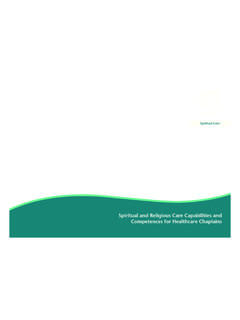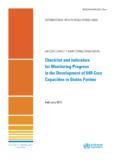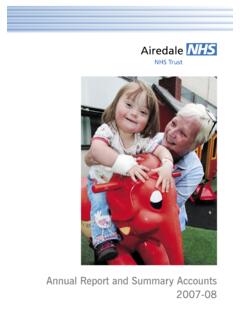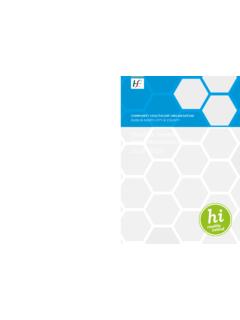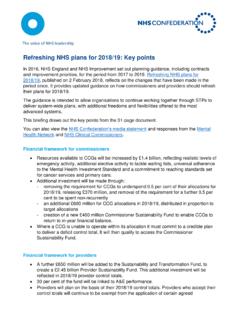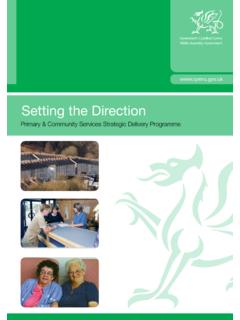Transcription of Safer Nursing Care Tool - Shelford Group
1 Safer Nursing care ToolImplementation Resource Pack 1 Setting the context ..22 Introduction to the tool ..53 A Brief Overview of the tool ..64 How is Acuity and Dependency Measured? ..85 Example Data Collection Tools ..96 How Do I Ensure That Accurate Data Are Collected ..127 What Nurse Sensitive Indicators are Allied to Acuity and Dependency? ..138 How to Use the Multipliers ..149 Occupancy ..1510 Top Tips from the Pilot and Field Test Sites? ..1511 Frequently Asked Questions ..1612 Who Can I Contact if I Need Help? ..1713 References ..17 Table of Contents* The Shelford Group is an organisation comprising the Chief Executives of ten of the leading NHS multi-specialty academic healthcare organisations in England.
2 The Chief Nurses of each of these NHS Trusts belong to a Sub- Group of the organisation and they meet every two months to share best-practice, benchmark and work towards improving standards in Nursing . Executive National LeadsProfessor Katherine Fenton OBE, Chief Nurse, University College London Hospitals NHS Foundation Trust and Professor Hilary Chapman CBE, Chief Nurse, Sheffield Teaching Hospitals NHS Foundation TrustNational Lead Nurses on behalf of Executive Leads:Ann Casey, Senior Nurse N&M Establishments, University College London Hospitals NHS Foundation Trust, Christine Bryer, Senior Nurse, Sheffield Teaching Hospitals NHS Foundation Trust and Sue Smith, Director of Nursing , Patient Safety & Quality, North Tees and Hartlepool NHS Foundation of tool and development of multipliersDr Keith Hurst, Independent Researcher /Analyst.
3 Editor, International Journal of Health care Quality AssuranceDepartment of Health Support for original version of tool : Ros Moore, then Nursing Officer DH England & WalesPilot sites University Hospital Southampton NHS Foundation Trust Barts Health NHS Trust University Hospitals Coventryand Warwickshire NHS Trust Guy s and St Thomas Hospital NHS Foundation Trust Hammersmith Hospitals NHS Trust Kings College Hospital NHS Foundation Trust University Hospitals of Leicester NHS Trust Oxford University Hospitals NHS Trust University College London Hospitals NHS Foundation Test Sites original version NHS Scotland Newham University Hospital NHS Trust Sheffield Teaching HospitalsNHS Foundation Trust Whipps Cross University Hospital NHS Trust Winchester & Eastleigh HealthcareNHS SitesThe Shelford
4 Group of Hospitals* consisting of the following: Cambridge University HospitalsNHS Foundation Trust Central Manchester University Hospitals NHS Foundation Trust Guy s and St Thomas Hospital NHS Foundation Trust Imperial College Healthcare NHS Trust King s College Hospital NHS Foundation Trust The Newcastle-upon-Tyne Hospitals NHS Foundation Trust Oxford University Hospitals NHS Trust Sheffield Teaching Hospitals NHS Foundation Trust University College London Hospitals NHS Foundation Trust University Hospitals Birmingham NHS Foundation Trust and AUKUH hospitals. Ashford and St. Peter s Hospitals NHS Foundation Trust Whipps Cross Hospital, London,part of Barts Health NHS TrustAcknowledgements 1 Background and descriptionEnsuring we have the right staff, with the right skills in the right place is Action Area 5 within Compassion in Practice (NHSCB 2012).
5 This emphasises the need for developing evidence-based, patient need-driven staffing levels in all care settings. The strategy also advocates that there is a twice yearly public Board level discussion to ratify and agree nurse staffing Safer Nursing care tool (SNCT) is one method that can be used to assist Chief Nurses to determine optimal nurse staffing SNCT is: An evidence based tool that enables nurses to assess patient acuity and dependency, incorporating a staffing multiplier to ensure that Nursing establishments reflect patient needs in acuity/dependency terms. Appropriate for use in any acute hospital within the UK (although further work is underway to refine the tool for use in particular clinical environments, see section on ongoing development of the tool Used in conjunction with Nurse Sensitive Indicators (NSI) such as patient falls, and pressure ulcer incidence, which can be linked to staffing Able to support benchmarking activity in organisations when used across Trusts.)
6 This will assist in facilitating consistent nurse-to-patient ratios in line with agreed standards across similar care settings in and validating the toolThe tool was validated by Dr. K. Hurst, (then based at the University of Leeds). This included recalibrating the tool using the Leeds Acuity-Quality database, which at that time included 1,000 best practice wards (those achieving a pre-determined quality rating) and some 119,000 Nursing interventions delivered to almost 2,800 patients in 14 care groups over two Setting the context for using the Safer Nursing care ToolThe SNCT tool was tested in Teaching and District General Hospitals in England and across NHS Scotland, to confirm that the tool was easy to 2012 the Shelford Chief Nurses Group commissioned an expert working Group including Dr.
7 Keith Hurst to review the tool , its definitions and multipliers to ensure the SNCT is still current and applicable. A full review was undertaken taking into consideration changes such as: The ageing population s impact on inpatient dependency and acuity; Rapid throughput and shorter patient-stays; Decreasing Registered Nurse direct- care time and the corresponding rise in support worker direct care time. New roles and support staff; , Band 4 Nursing Assistants* and Band 1-3 housekeepersThis required that the dual scoring exercise was repeated. 40,000 dual assessments were undertaken in October 2012 using the Leeds Dependency tool and Safer Nursing care tool to update the staffing the tool in conjunction with other methods to increase assuranceNursing workload and the ability to provide good care is influenced by many variables including patient acuity and dependency and other issues known to influence Nursing workload more locally; : The clinical model The labour market Staff capacity and capability,seniority and confidence Organisational factors.
8 , support roles, support external to the ward, ward layout Senior Sister / Charge Nurse supervisory time and leadership capability 2* includes HCAs/Assistant PractictionerNo national workforce tool can incorporate all factors and so combining methods (triangulation) is recommended to arrive at optimal staffing levels. This should include quantitative assessments such as those encapsulated in the SNCT and other more qualitative and professional judgement methods to increase confidence in recommended staffing levels and provide balanced Royal College of Nursing report (RCN 2010) also advocates triangulating different methods for calculating nurse staffing levels. Appendix 1 summarises other methods available to help determine nurse establishments, which can be used for triangulation we getting the results we want?
9 Monitoring Nurse Sensitive IndicatorsLinks between patient acuity and dependency, workload, staffing and quality have been established in recent years. Evidence in the literature links low staffing levels and skill mix ratios to adverse patient outcomes (Rafferty et al. 2007; NPSA 2009).Monitoring Nurse Sensitive Indicators (NSIs) such as infection rates, complaints, pressure ulcers and falls is therefore recommended to ensure that staffing levels determined in the ways described above, deliver the patient outcomes that we aim to achieve. Within the SNCT these data are converted into a rate per 1,000 occupied bed days thus allowing consistent comparison across wards and Trusts help to ensure optimum staffing the NSIs are adverse then staffing levels require prompt review to test if the initial recommendations remain appropriate.
10 It is important to exclude factors that may compromise workforce numbers, such as high turnover, sickness, leave or unfilled , there may be other factors that compromise workforce efficacy including competence, inadequate leadership, poor morale and poor compliance with good practice all of which will require redress through other development of the toolThe adult, generic Safer Nursing care tool is not validated for use in Acute Medical Unit/Medical admission wards. The model is currently being developed for use in these areas and will be released when tool is also being further developed to better reflect the complexities of caring for older people in acute care wards; this version is almost ready for , work has been commissioned and is in progress to develop a similar tool for use in Accident and Emergency Ruth May, Regional Chief Nurse, NHS England, (Midlands and East) leads the implementation of Action Area 5 and learning from the experience in NHS Scotland, work is underway to develop SNCT for use in other care settings - Community, Mental Health and Learning Disabilities in the first Chief Nurse GroupMay 2013 3 Appendix 1.


